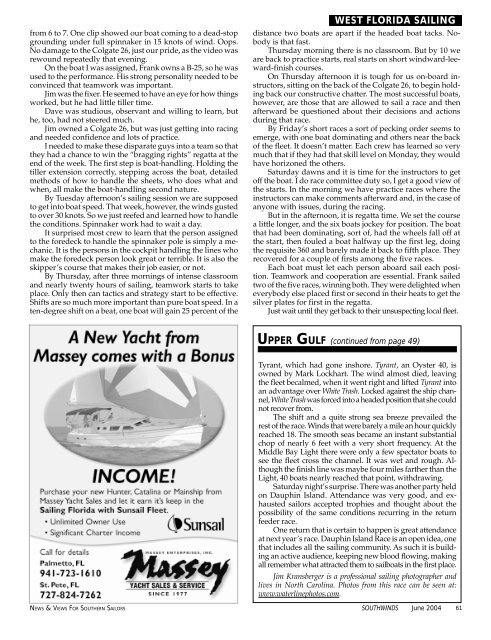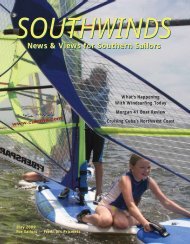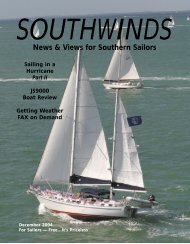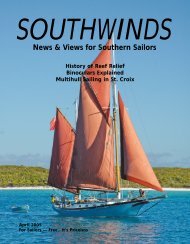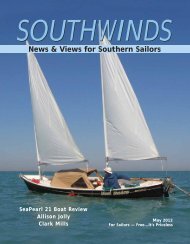Southwinds Sailing June 2004 - Southwinds Magazine
Southwinds Sailing June 2004 - Southwinds Magazine
Southwinds Sailing June 2004 - Southwinds Magazine
- No tags were found...
Create successful ePaper yourself
Turn your PDF publications into a flip-book with our unique Google optimized e-Paper software.
from 6 to 7. One clip showed our boat coming to a dead-stopgrounding under full spinnaker in 15 knots of wind. Oops.No damage to the Colgate 26, just our pride, as the video wasrewound repeatedly that evening.On the boat I was assigned, Frank owns a B-25, so he wasused to the performance. His strong personality needed to beconvinced that teamwork was important.Jim was the fixer. He seemed to have an eye for how thingsworked, but he had little tiller time.Dave was studious, observant and willing to learn, buthe, too, had not steered much.Jim owned a Colgate 26, but was just getting into racingand needed confidence and lots of practice.I needed to make these disparate guys into a team so thatthey had a chance to win the “bragging rights” regatta at theend of the week. The first step is boat-handling. Holding thetiller extension correctly, stepping across the boat, detailedmethods of how to handle the sheets, who does what andwhen, all make the boat-handling second nature.By Tuesday afternoon’s sailing session we are supposedto get into boat speed. That week, however, the winds gustedto over 30 knots. So we just reefed and learned how to handlethe conditions. Spinnaker work had to wait a day.It surprised most crew to learn that the person assignedto the foredeck to handle the spinnaker pole is simply a mechanic.It is the persons in the cockpit handling the lines whomake the foredeck person look great or terrible. It is also theskipper’s course that makes their job easier, or not.By Thursday, after three mornings of intense classroomand nearly twenty hours of sailing, teamwork starts to takeplace. Only then can tactics and strategy start to be effective.Shifts are so much more important than pure boat speed. In aten-degree shift on a beat, one boat will gain 25 percent of theWEST FLORIDA SAILINGdistance two boats are apart if the headed boat tacks. Nobodyis that fast.Thursday morning there is no classroom. But by 10 weare back to practice starts, real starts on short windward-leeward-finishcourses.On Thursday afternoon it is tough for us on-board instructors,sitting on the back of the Colgate 26, to begin holdingback our constructive chatter. The most successful boats,however, are those that are allowed to sail a race and thenafterward be questioned about their decisions and actionsduring that race.By Friday’s short races a sort of pecking order seems toemerge, with one boat dominating and others near the backof the fleet. It doesn’t matter. Each crew has learned so verymuch that if they had that skill level on Monday, they wouldhave horizoned the others.Saturday dawns and it is time for the instructors to getoff the boat. I do race committee duty so, I get a good view ofthe starts. In the morning we have practice races where theinstructors can make comments afterward and, in the case ofanyone with issues, during the racing.But in the afternoon, it is regatta time. We set the coursea little longer, and the six boats jockey for position. The boatthat had been dominating, sort of, had the wheels fall off atthe start, then fouled a boat halfway up the first leg, doingthe requisite 360 and barely made it back to fifth place. Theyrecovered for a couple of firsts among the five races.Each boat must let each person aboard sail each position.Teamwork and cooperation are essential. Frank sailedtwo of the five races, winning both. They were delighted wheneverybody else placed first or second in their heats to get thesilver plates for first in the regatta.Just wait until they get back to their unsuspecting local fleet.UPPER GULF (continued from page 49)Tyrant, which had gone inshore. Tyrant, an Oyster 40, isowned by Mark Lockhart. The wind almost died, leavingthe fleet becalmed, when it went right and lifted Tyrant intoan advantage over White Trash. Locked against the ship channel,White Trash was forced into a headed position that she couldnot recover from.The shift and a quite strong sea breeze prevailed therest of the race. Winds that were barely a mile an hour quicklyreached 18. The smooth seas became an instant substantialchop of nearly 6 feet with a very short frequency. At theMiddle Bay Light there were only a few spectator boats tosee the fleet cross the channel. It was wet and rough. Althoughthe finish line was maybe four miles farther than theLight, 40 boats nearly reached that point, withdrawing.Saturday night’s surprise. There was another party heldon Dauphin Island. Attendance was very good, and exhaustedsailors accepted trophies and thought about thepossibility of the same conditions recurring in the returnfeeder race.One return that is certain to happen is great attendanceat next year’s race. Dauphin Island Race is an open idea, onethat includes all the sailing community. As such it is buildingan active audience, keeping new blood flowing, makingall remember what attracted them to sailboats in the first place.Jim Kransberger is a professional sailing photographer andlives in North Carolina. Photos from this race can be seen at:www.waterlinephotos.com.NEWS & VIEWS FOR SOUTHERN SAILORS SOUTHWINDS <strong>June</strong> <strong>2004</strong> 61


